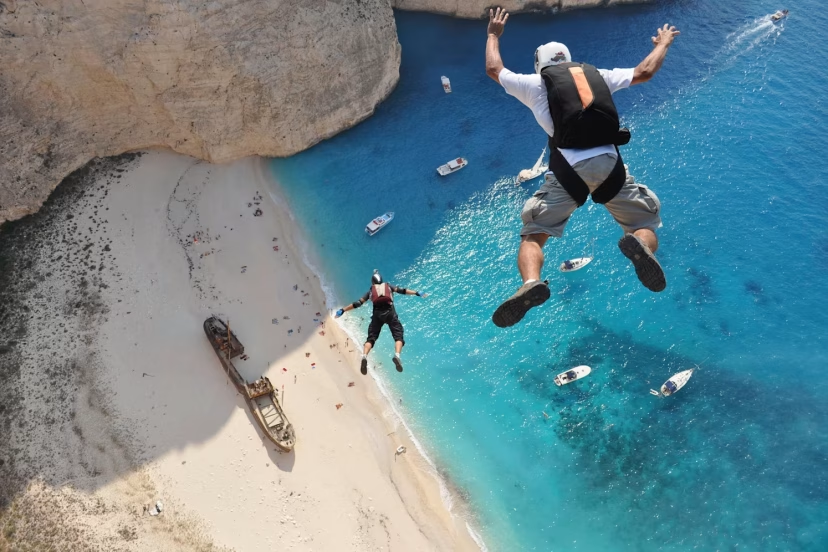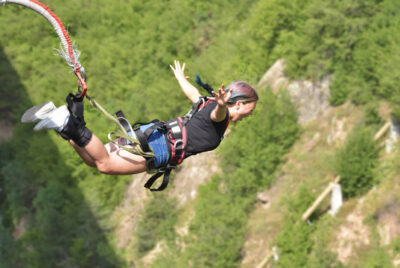BASE Jumping – A Beginner’s Guide to This Extreme Sport
Have you ever stood at the edge of a cliff, feeling the wind whip through your hair, and wondered what it would be like to step off into nothing but air? That heart-stopping moment—that’s the essence of BASE jumping, one of the most exhilarating and dangerous adventure sports on Earth.
BASE jumping isn’t just another adrenaline rush. It’s a lifestyle, a community, and for many jumpers, a profound way to experience human flight in its purest form. But before you picture yourself soaring off El Capitan or the Petronas Towers, there’s a lot you need to know.
What Is BASE Jumping? Breaking Down the Extreme Sport
BASE is an acronym that stands for the four types of fixed objects you can jump from:
- Building
- Antenna
- Span (bridges)
- Earth (cliffs and natural formations)
Unlike skydiving, where you leap from an aircraft flying thousands of feet above the ground, BASE jumping involves jumping from fixed structures at much lower altitudes—sometimes as low as 300 feet. This fundamental difference is what makes BASE jumping both uniquely thrilling and inherently more dangerous.
“The moment before you jump, everything goes quiet,” says veteran BASE jumper Sarah McKinley. “Time slows down. It’s just you, the edge, and the decision to step off into empty space. Nothing else in life compares to that feeling.”
BASE Jumping vs. Skydiving: Critical Differences You Need to Understand
Many people mistakenly assume BASE jumping is just skydiving from a different launch point. This couldn’t be further from the truth.
When you skydive, you typically exit an aircraft at 10,000-13,000 feet, giving you about 60 seconds of freefall before deploying your parachute. You also wear a reserve parachute and an automatic activation device (AAD) that will deploy your reserve if you’re still in freefall at a dangerous altitude.
In contrast, BASE jumping offers:
- Much lower altitudes (300-3,000 feet typically)
- No reserve parachute (there’s simply not enough time for it to deploy)
- No AAD
- Only seconds to react if something goes wrong
- Proximity to the object you jumped from (creating additional hazards)
- Unpredictable wind conditions near structures and terrain
“Skydiving forgives small mistakes,” explains Tom Rogers, a BASE jumping instructor with over 1,500 jumps. “BASE jumping punishes them. That’s why we insist on extensive skydiving experience before anyone attempts their first BASE jump.”
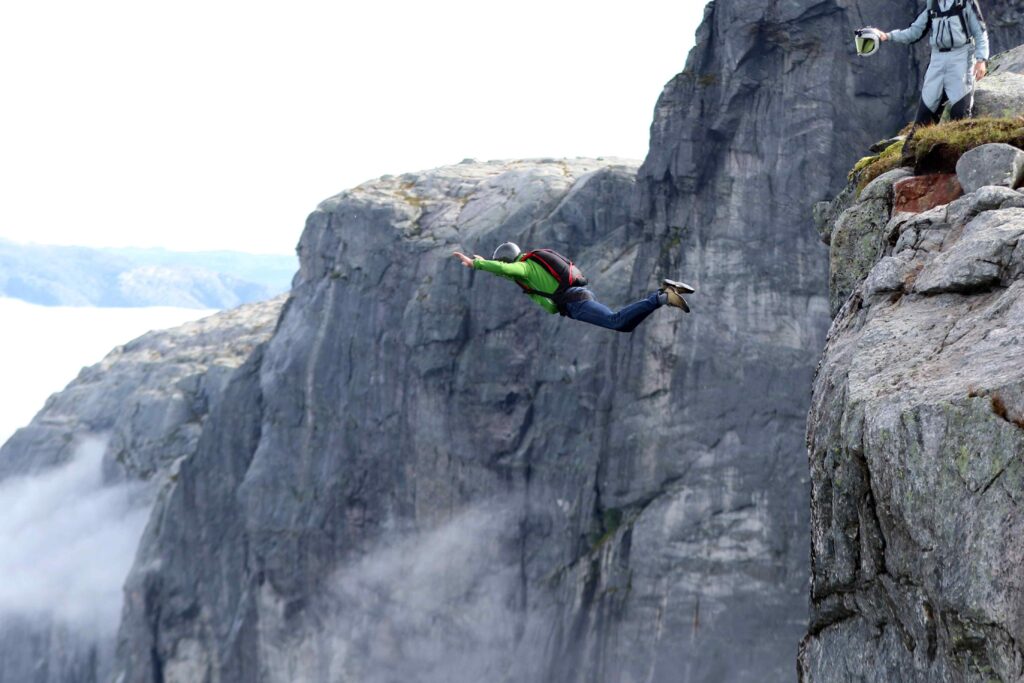
The Psychological and Physical Requirements for BASE Jumping
BASE jumping isn’t merely about physical ability—though that’s certainly important. The mental aspects of the sport are equally, if not more, crucial.
Mental Fortitude Required
BASE jumping demands:
- Exceptional focus and presence of mind
- The ability to make split-second decisions under extreme pressure
- Emotional control and fear management
- Meticulous attention to detail during preparation
- Patience to wait for optimal conditions (even if you’ve traveled far for a jump)
“Your mind needs to be sharper than your body,” says psychologist and BASE jumper Dr. Elena Vasquez. “When you’re standing on that edge, any distraction—relationship problems, work stress, even excitement about the jump itself—can be deadly. You must be completely present.”
Physical Requirements
Physically, BASE jumpers need:
- Core strength for stability during freefall
- Lower body strength for safe landings
- Flexibility to absorb impact
- Cardiovascular fitness for approach hikes and to maintain calm under stress
- Good proprioception (awareness of body position)
Consider implementing a training regimen that includes plyometrics, yoga for flexibility, and cardiovascular conditioning at least three months before your first jump.
The Experience Prerequisite: Why 200+ Skydives Is Just the Beginning
The BASE jumping community has established a strong consensus: you need at least 200 skydives before attempting your first BASE jump. Some instructors and mentors may require even more.
These 200+ jumps aren’t arbitrary. They ensure you’ve developed:
- Instinctive body position control in freefall
- Automatic emergency response procedures
- Comfort with equipment malfunctions
- Accurate canopy piloting skills
- Consistent landing precision
“Those 200 skydives teach you the basics,” says Marco Waltenspiel, professional BASE jumper. “But what they’re really doing is giving you enough experience to know what you don’t know yet. That humility keeps you alive in BASE.”
During your skydiving progression, focus specifically on:
- Tracking jumps (moving horizontally during freefall)
- Canopy control courses
- Accuracy landing competitions
- Low-pull practice (with supervision)
Understanding the Real Risks: BASE Jumping Fatality Statistics
Let’s be brutally honest: BASE jumping is dangerous. According to the BASE Fatality List, which tracks deaths in the sport, there have been hundreds of fatalities since tracking began in the 1980s.
The fatality rate in BASE jumping is estimated to be roughly 1 death per 2,000 jumps, compared to skydiving’s 1 in 100,000 jumps. What makes it so dangerous?
- No time for reserve deployment
- Proximity to objects during freefall
- Unpredictable wind conditions near structures
- Landing zones that are often small and technical
- The psychological pressure of the environment
“The statistics sound grim,” acknowledges Chris McDougall, who has been BASE jumping for over a decade. “But they don’t tell the whole story. Many accidents happen to people who skip steps in their progression or jump in questionable conditions. Respect the process, and you significantly reduce your risk.”
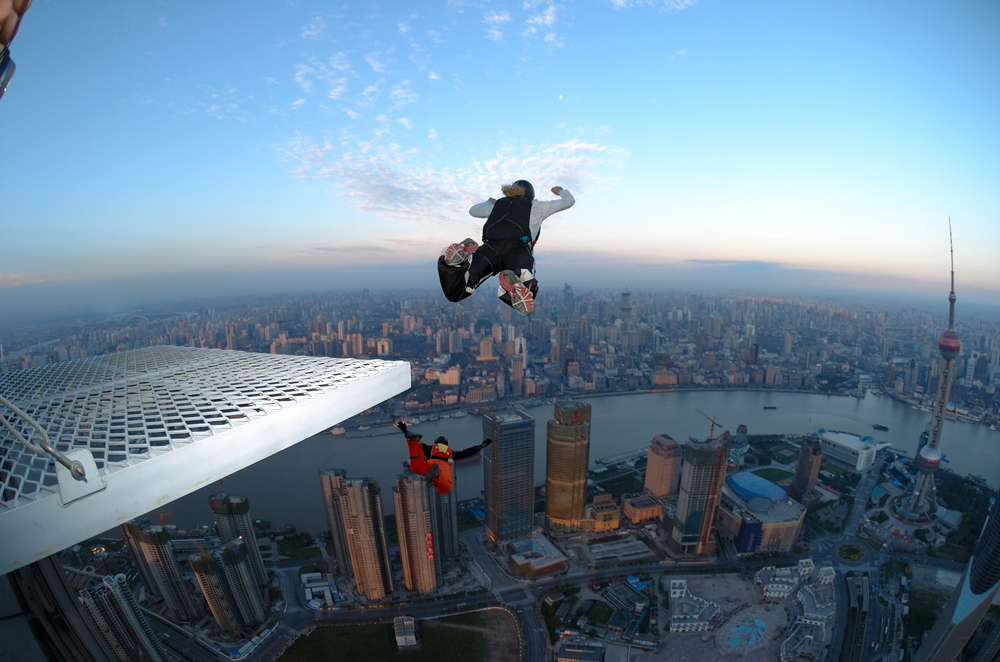
Finding the Right Mentor: Your Lifeline to Safe BASE Jumping
Perhaps nothing is more important to your BASE jumping journey than finding the right mentor. This isn’t something you learn from YouTube videos or weekend workshops.
A good BASE mentor:
- Has 5+ years of active jumping experience
- Maintains connections in the BASE community
- Puts safety above thrills
- Is willing to say “no” when conditions aren’t right
- Teaches methodically rather than rushing your progression
“My mentor made me pack and repack my parachute 50 times before my first jump,” recalls Lisa Chen, who now has over 300 BASE jumps. “He made me practice gear checks until I could do them blindfolded. I was frustrated then, but now I know he was keeping me alive.”
How do you find a mentor? Start in the skydiving community. Make it known you’re interested in BASE, but approach the subject with respect and patience. The right mentor will likely find you once you’ve proven your dedication to learning properly.
Essential BASE Jumping Gear: What You Need and Why It’s Different
BASE gear differs significantly from skydiving equipment, with each piece designed specifically for the unique demands of jumping from fixed objects.
The BASE-Specific Parachute System
Your BASE rig will include:
- A container designed for BASE-specific canopies
- A larger pilot chute (the small parachute that pulls out your main canopy)
- A bridle (connecting line between pilot chute and main canopy) that’s typically longer than those used in skydiving
- A main canopy designed for quick opening and stability
Most BASE jumpers use a 7-cell canopy ranging from 200-260 square feet, depending on the jumper’s weight. These canopies are designed to open quickly, predictably, and on-heading—critical when you’re falling close to a structure.
Protective Gear: Non-Negotiable Safety Equipment
At minimum, you’ll need:
- A full-face helmet
- Impact-rated knee and elbow pads
- A flexible back protector
- Sturdy ankle support boots with good grip
“I’ve seen a $200 helmet save someone from a $200,000 medical bill,” says equipment specialist Jake Donovan. “When it comes to protective gear, buy the best you can afford. Your life literally depends on it.”
Total Investment: Preparing for the Cost
A complete BASE setup will cost approximately:
- BASE-specific container and canopy:
- Protective gear:
- Specialized clothing:
- Miscellaneous equipment (altimeter, hook knife, etc.)
Total: $3,500-5,700 for quality equipment
Consider this investment carefully. Cutting corners on BASE equipment is never worth the risk.
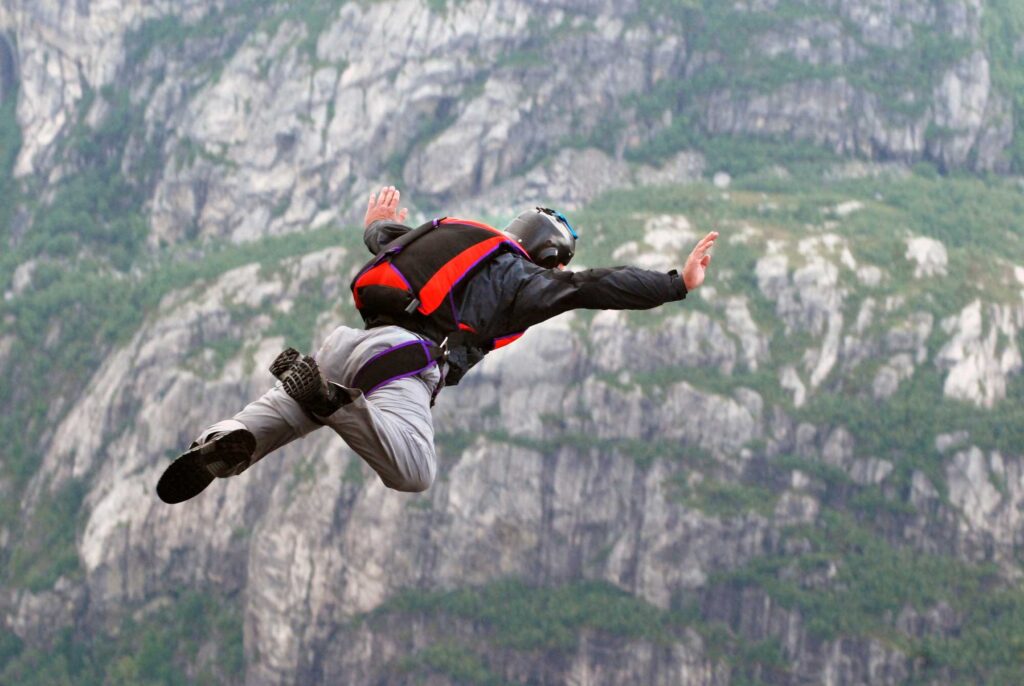
Your First BASE Jump: A Step-by-Step Preparation Guide
When you’ve completed your skydiving prerequisites and found a mentor, preparing for your first BASE jump becomes a methodical process.
Selection of Your First Jump Site
Ideal first BASE jumps typically have:
- Altitude of at least 500 feet
- Clean air space with no obstacles
- Large, forgiving landing areas
- Consistent wind patterns
- Legal access (important for both ethical and practical reasons)
Classic first-jump locations include bridges over rivers or dams where the landing zone is wide open and the object itself is simple to exit from.
Pre-Jump Preparation Checklist
- Weather assessment: Check wind speeds at exit point and landing zone. Ideally, winds should be under 5mph.
- Gear check: Triple-check your equipment using a written checklist.
- Mental rehearsal: Visualize the entire jump sequence from exit to landing.
- Physical warm-up: Perform light stretching to ensure flexibility for exit and landing.
- Communication plan: Establish signals with your mentor and ground crew.
“The preparation might seem excessive,” says first aid specialist and BASE jumper Dr. Michael Lee. “But in BASE, thoroughness before the jump prevents tragedy during it.”
The Jump Sequence: What to Expect
Your first BASE jump will likely follow this sequence:
- Approach: Reach your exit point calmly and deliberately.
- Set up: Position yourself precisely as practiced.
- Count: Use a consistent count pattern (typically “ready, set, go”).
- Exit: Push off decisively in the practiced body position.
- Freefall: Maintain a stable arch position.
- Deployment: Pull your pilot chute at the predetermined count.
- Canopy check: Quickly assess your open canopy.
- Navigation: Fly to your planned landing area.
- Landing: Prepare for precision approach and landing.
“Your first BASE jump will be a blur,” warns veteran jumper David Lafferty. “That’s why we practice the sequence hundreds of times before you ever step to the edge. When the adrenaline hits, you’ll fall back on that training.”
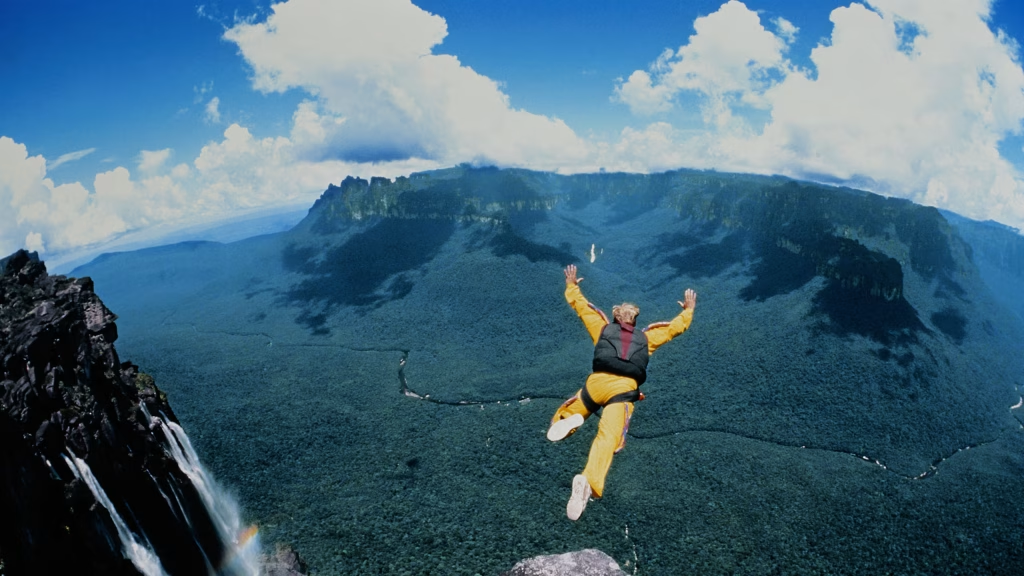
Legal and Ethical Considerations in BASE Jumping
BASE jumping exists in a legal gray area in many locations. While some sites like the Perrine Bridge in Twin Falls, Idaho, permit legal jumping year-round, many iconic BASE locations require jumping at dawn or dusk to avoid detection.
Consider these ethical guidelines:
- Always seek permission when jumping from private property
- Respect closures and restrictions
- Leave no trace at exit points and landing zones
- Represent the BASE community positively in interactions with the public
- Mentor new jumpers responsibly once you have experience
“The future of BASE jumping depends on how we conduct ourselves today,” emphasizes community advocate Maria Schultz. “One jumper trespassing or being disrespectful can close a site for everyone for years.”
Progression in BASE Jumping: Building Skills Safely
After your first jump, a careful progression path includes:
- Mastering basic exits (5-10 jumps from the same object)
- Different objects at similar heights (next 10-20 jumps)
- Tracking jumps (learning to move horizontally during freefall)
- Higher objects (increasing delay before deployment)
- Technical landing areas (gradually increasing difficulty)
“Rush this progression, and you’re writing checks your skills can’t cash,” cautions progression specialist Rob Daniels. “I’ve seen too many talented jumpers push too fast and pay the ultimate price.”
The BASE Community: Finding Your Tribe
One of the most rewarding aspects of BASE jumping is the tight-knit community. These are people who understand the unique blend of fear, exhilaration, and peace that comes from human flight.
Connect with the community through:
- BASE-specific forums and social media groups
- Jumper meetups at legal locations
- Volunteering at BASE competitions
- Training camps and workshops
“The relationships you build in BASE often become the strongest in your life,” reflects community organizer Jessica Thompson. “There’s something about sharing these extreme experiences that creates unbreakable bonds.”
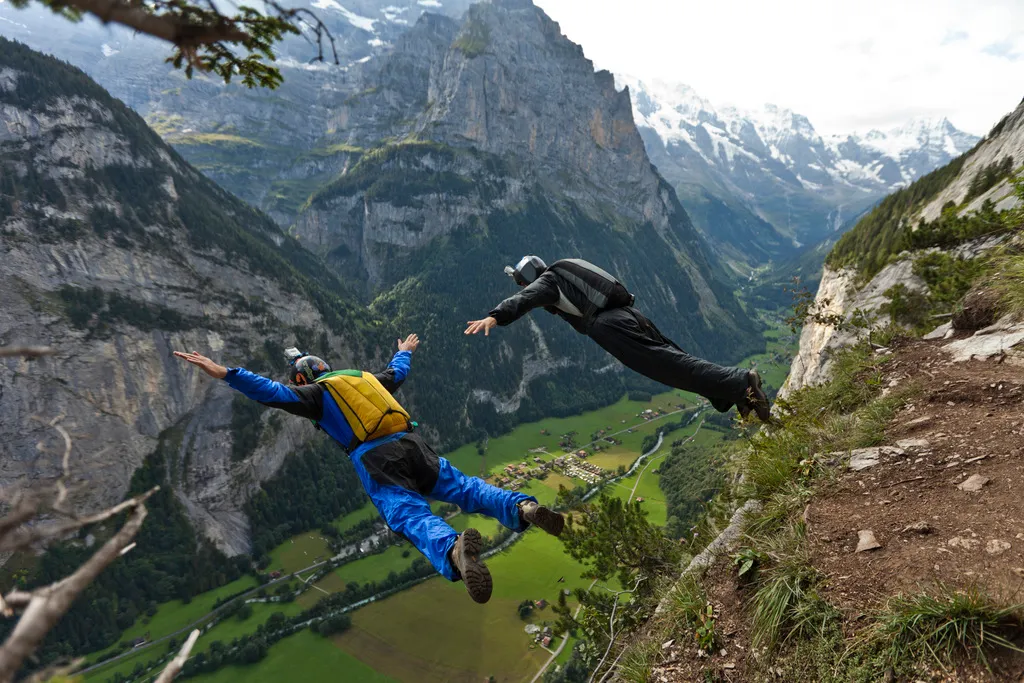
Conclusion: Is BASE Jumping Right for You?
BASE jumping offers an unparalleled experience of human flight—a blend of extreme focus, breathtaking views, and the purest expression of freedom many jumpers ever find. But it comes with real risks that cannot be eliminated, only managed through proper training, equipment, and decision-making.
If you’re drawn to BASE jumping, approach it with patience and respect. The path is long—often years of preparation before that first leap—but those who follow it correctly often find something transformative.
“BASE jumping isn’t just an extreme sport,” concludes world-renowned jumper Anna Klosky. “It’s a journey into yourself—your fears, your discipline, your ability to be completely present in a moment where nothing else matters. That’s why we jump. Not for the Instagram photos or bragging rights, but for those perfect moments of absolute clarity you can’t find anywhere else.”
Whether you ultimately decide to pursue BASE jumping or simply appreciate it from afar, understanding the depth of preparation and respect the sport requires gives you insight into one of humanity’s most extreme pursuits—the quest to fly free, if only for a moment.
Frequently Asked Questions About BASE Jumping
How long does it typically take to become a BASE jumper?
Most jumpers spend 2-3 years building skydiving experience before their first BASE jump, then another 1-2 years developing BASE-specific skills.
What’s the minimum legal age for BASE jumping?
While there’s no universal minimum age, most mentors and courses require participants to be at least 21 years old, with many preferring jumpers to be 25+ due to risk assessment maturity.
Can you BASE jump in bad weather?
Experienced jumpers might jump in light winds or specific conditions, but as a beginner, you should only jump in optimal weather—clear skies, winds under 5mph, and good visibility.
How do I find legal places to BASE jump?
The Perrine Bridge (Idaho), Kuala Lumpur Tower (during official events), and New River Gorge Bridge (on Bridge Day) are among the few consistently legal jumping locations worldwide.
What’s the difference between a BASE rig and a skydiving rig?
BASE rigs have no reserve parachute, larger pilot chutes, different deployment systems, and canopies designed to open quickly at lower airspeeds.

